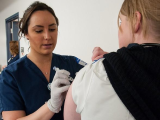Apr 20, 2011
Ohio estimates benefits of H1N1 vaccination during pandemic
On the basis of its own research, the Ohio Department of Health (ODH) estimates that its 2009 H1N1 vaccination efforts prevented 64 deaths, 1,400 hospitalizations, and 310,402 influenza cases during the 2009 pandemic. The vaccination drive also saved the state an estimated $8.4 million in H1N1-related hospital costs, the agency said in a press release today. The ODH estimated the number of deaths, hospitalizations, and illnesses prevented from Apr 12, 2009, through Apr 10, 2010. The researchers used a model published by the Centers for Disease Control and Prevention to come up with the estimates. The ODH ordered and shipped 4.1 million doses of H1N1 vaccine to more than 3,000 providers during the pandemic, and it also released more than $50 million in federal public health preparedness funds to support vaccination clinics and other prevention efforts. "Ohio's local health departments sponsored hundreds of mass vaccination clinics and provided strong local leadership that was integral in our success," ODH Director Dr. Ted Wymyslo said in the press release.
Apr 20 ODH press release
Online self-identification tool accurately reflected H1N1 on campus
An online system for Ontario university students to self-identify flu-like symptoms during the 2009 H1N1 influenza pandemic was effective for surveillance and for lessening the burden on campus medical staff, a study found. Reporting in the Journal of American College Health, researchers say that 1,432 students at Brock University in St. Catharines, Ont., used the Web-based tool, and data show that the tool accurately reflected levels of absenteeism and flu on campus. The authors conclude, "The online, real-time surveillance tool was effective in monitoring influenza activity on campus, providing timely health advice, decreasing unnecessary visits to the campus medical clinic, and assisting local public health in surveillance activities."
Apr J Am Coll Health abstract
Survey tracks kids' flu vaccine preferences
When it comes to flu vaccines, children rated efficacy and the intranasal route of delivery as the most important attributes, according to a survey designed to gauge their preferences. The survey report, published online yesterday by Vaccine, was sponsored and partially designed by MedImmune, the maker of FluMist, the live attenuated influenza vaccine (LAIV). It included responses from 544 children aged 8 through 12 years who took part in a nationally representative online panel in August and September of 2009. The children were recruited through their parents' participation in a nationwide online panel. The poll also asked kids to weigh different vaccine attributes and was designed to gauge their comprehension of the issues and the consistency of their answers. Efficacy was most frequently selected as the most important attribute at 45%, followed by mode of administration at 31%. The majority (69%) said they preferred the nasal spray. The authors found that 85% of children were able to complete the survey task. The group concluded that children's answers were consistent and that children can be included in discussions about flu vaccination.
Apr 19 Vaccine abstract
H5 avian flu found in whooper swans in Mongolia
Three whooper swans that were found dead on a lake in eastern Mongolia tested positive for an H5 avian influenza virus, according to a report Mongolian officials filed today with the World Organization for Animal Health (OIE). The swans were found at Zegst Lake in Sukhbaatar province. In other developments, a low-pathogenicity flu virus found in poultry in eastern Nebraska has been identified as an H7N9 subtype, a US Department of Agriculture official reported via ProMED-mail, the disease reporting system of the International Society for Infectious Diseases. The posting by Randall L. Levings said an H7N9 virus was isolated from geese and guinea fowl in a backyard flock. The virus's pathogenicity in chickens is being tested, he said.
Apr 20 OIE report from Mongolia
Apr 19 ProMED-mail report




















